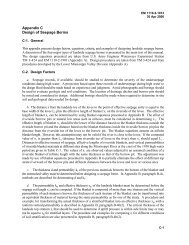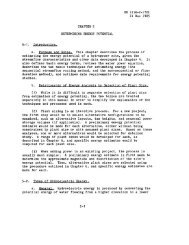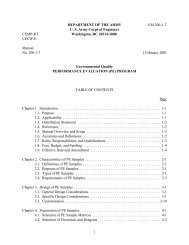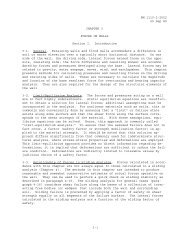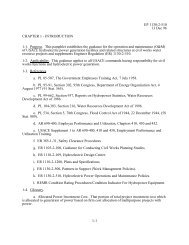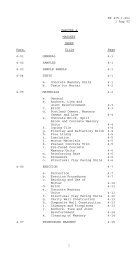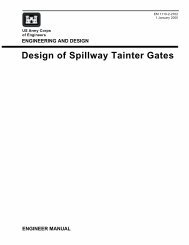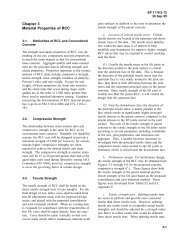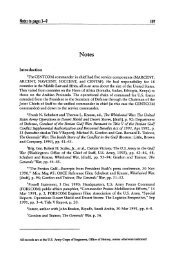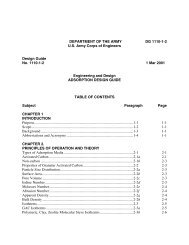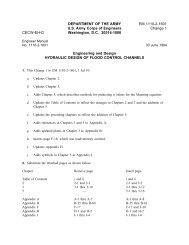Earthquake Design and Evaluation of Concrete Hydraulic Structures
Earthquake Design and Evaluation of Concrete Hydraulic Structures
Earthquake Design and Evaluation of Concrete Hydraulic Structures
Create successful ePaper yourself
Turn your PDF publications into a flip-book with our unique Google optimized e-Paper software.
EM 1110-2-6053<br />
1 May 2007<br />
distribution that could produce large overturning moment. In this situation a pure rocking or<br />
combined rocking plus sliding seems more plausible.<br />
(3) Response to stability controlled actions<br />
(a) General. Lightly reinforced concrete structures are most vulnerable to failure by fracturing<br />
<strong>of</strong> the flexural reinforcing steel. Once the flexural reinforcing steel fractures, the seismic<br />
evaluation becomes one <strong>of</strong> determining if the residual capacity <strong>of</strong> the cracked structure with ruptured<br />
reinforcing steel is adequate to prevent a failure by sliding instability, or by rotational instability.<br />
For sliding, the residual capacity is the shear-friction resistance <strong>of</strong> the concrete with no<br />
consideration given to the shear-friction resistance provided by the reinforcing steel. For rotation,<br />
the residual capacity or stabilizing moment is that provided by the moment resisting couple<br />
formed between the axial load <strong>and</strong> the concrete compressive stress zone formed at the extremity<br />
<strong>of</strong> the concrete section (Figure 2-9).<br />
(b) Sliding stability. The sliding response will be as illustrated in Figure 2-8d. The capacity<br />
to resist sliding will be based on shear-friction principles except that the shear-friction contribution<br />
from reinforcing steel crossing the failure plane will be ignored. In cases where the sliding<br />
shear dem<strong>and</strong> exceeds the sliding resistance (shear-friction capacity), an estimate <strong>of</strong> the permanent<br />
displacement can be made using the upper bound sliding displacement method described<br />
in Chapters 4 <strong>and</strong> 7. Non-linear analysis methods are also available for determining the<br />
permanent displacement that might occur as the result <strong>of</strong> the fracturing <strong>of</strong> the flexural reinforcing<br />
steel (Fronteddu, Leger, <strong>and</strong> Tinawi, 1998).<br />
(c) Rotational stability. Once a tower has suffered a through crack at its base due to high<br />
seismic moments, it could undergo rocking response if the moment dem<strong>and</strong>s exceed the restoring<br />
or resisting moment <strong>of</strong> Equation 2-3. For the purpose <strong>of</strong> rocking response, the tower may be<br />
considered a rigid block. Depending on the magnitude <strong>and</strong> form <strong>of</strong> the ground motion, the tower<br />
may translate with the ground, slide, rock, or slide <strong>and</strong> rock. Assuming that the angle <strong>of</strong> friction<br />
is so large that sliding will not occur, the tower initially rotates in one direction, <strong>and</strong>, if it does not<br />
overturn, it will then rotate in the opposite direction, <strong>and</strong> so on until it stops. There are fundamental<br />
differences between the oscillatory response <strong>of</strong> a single-degree-<strong>of</strong>-freedom (SDOF) oscillator<br />
<strong>and</strong> the rocking response <strong>of</strong> a slender rigid block (Makris <strong>and</strong> Kostantinidis, 2001). Rocking<br />
structures cannot be replaced by “equivalent” SDOF oscillators. The rocking response <strong>of</strong><br />
structures should be evaluated by solving equations that govern the rocking motion, as described<br />
in Chapter 7. The quantities <strong>of</strong> interest for a rocking block are its rotation, θ, <strong>and</strong> its angular<br />
velocity θ . Similar to the response spectra <strong>of</strong> SDOF oscillators, rocking response spectra<br />
which are plots <strong>of</strong> the maximum rotation <strong>and</strong> angular velocity vs. the frequency parameter <strong>of</strong><br />
geometrically similar blocks can be produced for rocking response. The rocking response spectra<br />
can then be used directly to obtain the maximum uplift or rotation <strong>of</strong> the block for a given<br />
ground motion. A comparison <strong>of</strong> the estimated maximum rotation with the slenderness ratio (i.e.<br />
α in Figure 7-5) <strong>of</strong> the block will indicate whether the block will overturn in accordance with the<br />
procedure described in Chapter 7.<br />
&<br />
(d) Toe crushing. In rocking mode the entire weight <strong>of</strong> the tower is exerted on a small region<br />
called the toe <strong>of</strong> the tower. The resulting compressive stresses in the toe region could be high<br />
enough to either crush the concrete or the foundation rock below. In either case this has the effect<br />
<strong>of</strong> reducing the moment lever arm from (h/a) to (h-a)/2, as illustrated in Figure 2-9. Should<br />
this happen the stabilizing or resisting moment (Mr) discussed in paragraph 2-5b(3)(c) should be<br />
computed as follows:<br />
2-12




